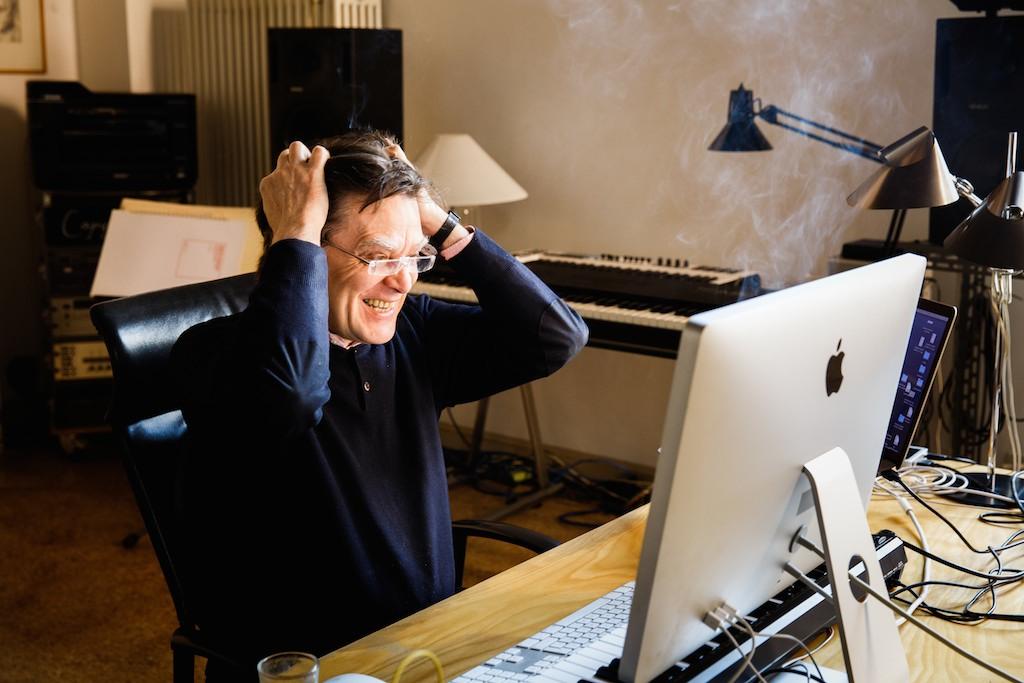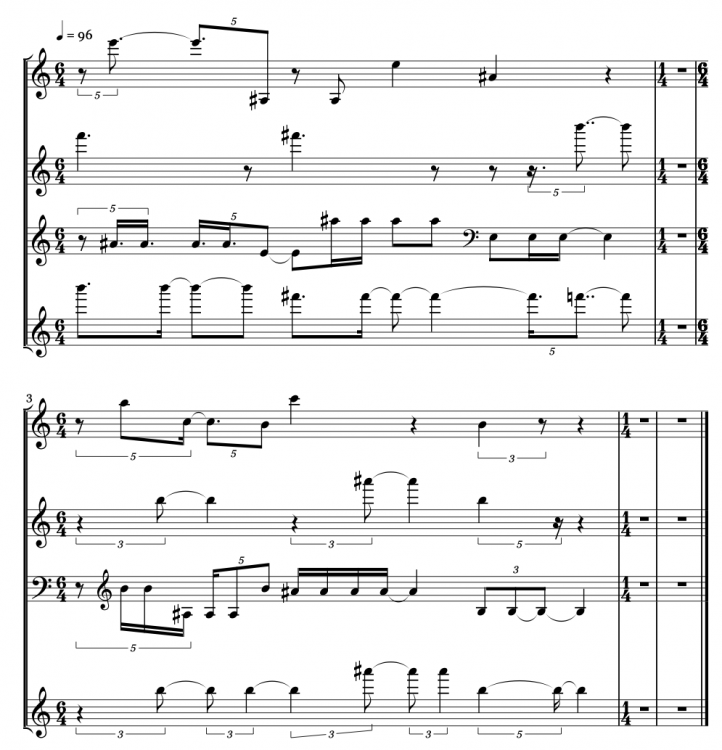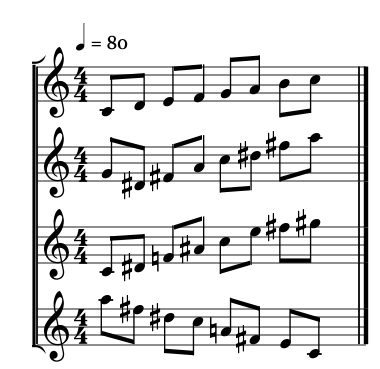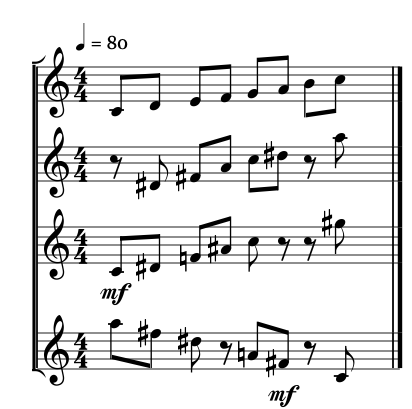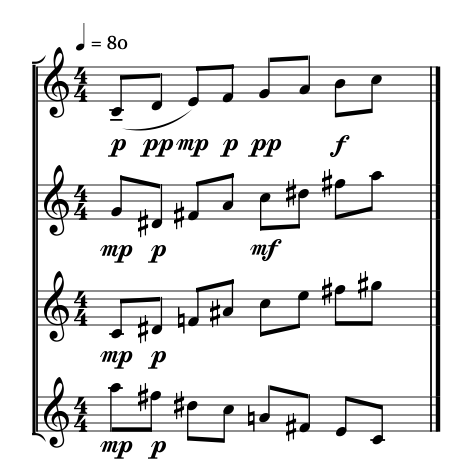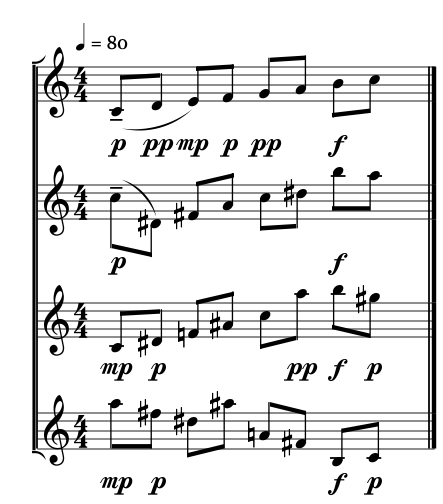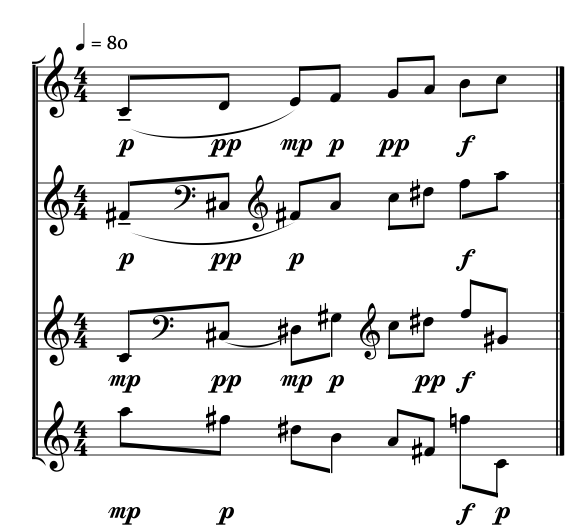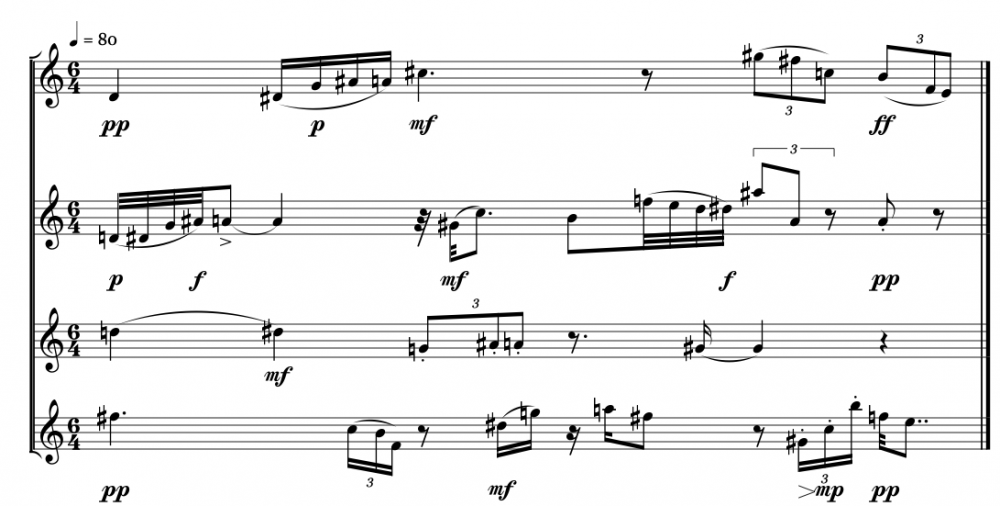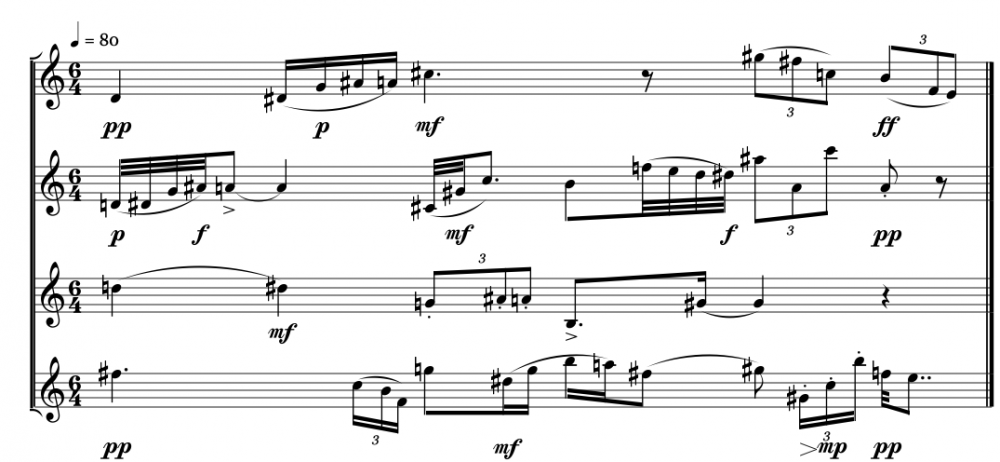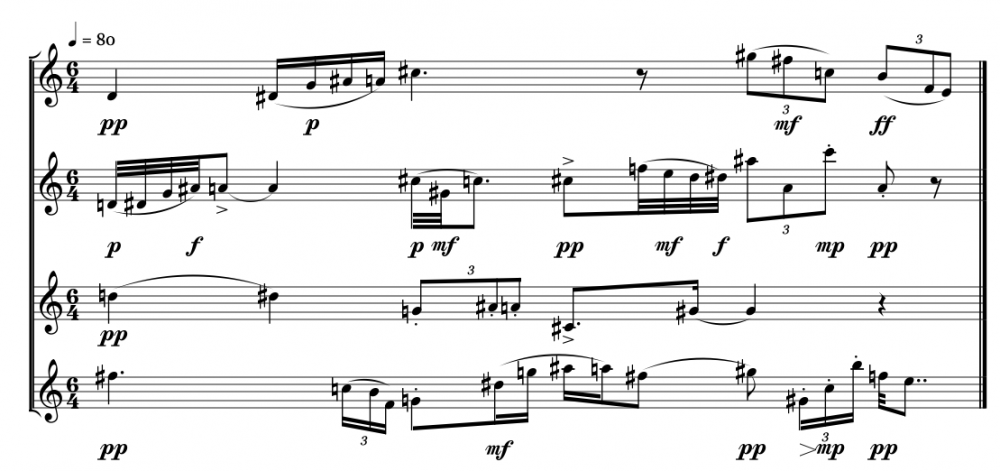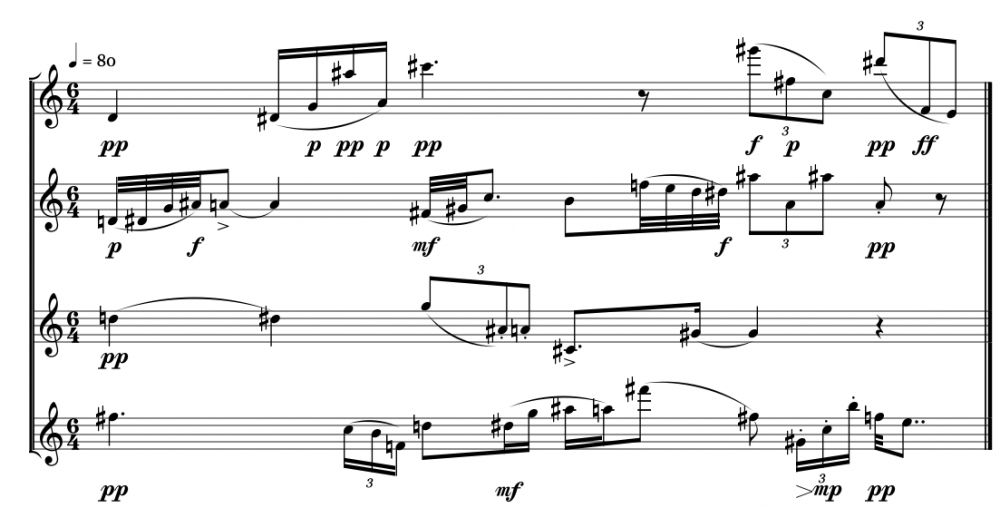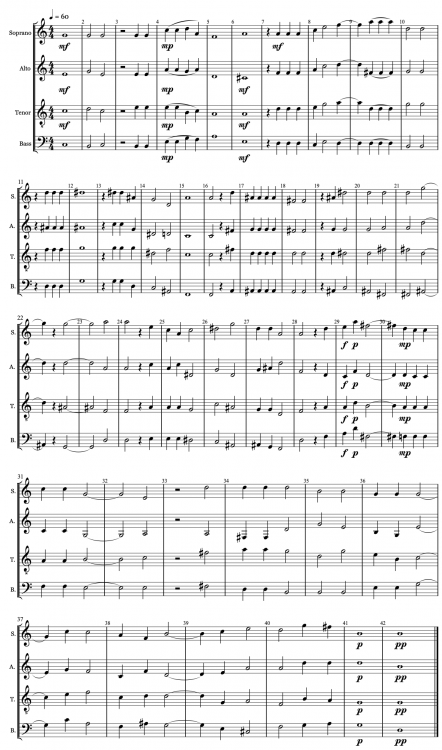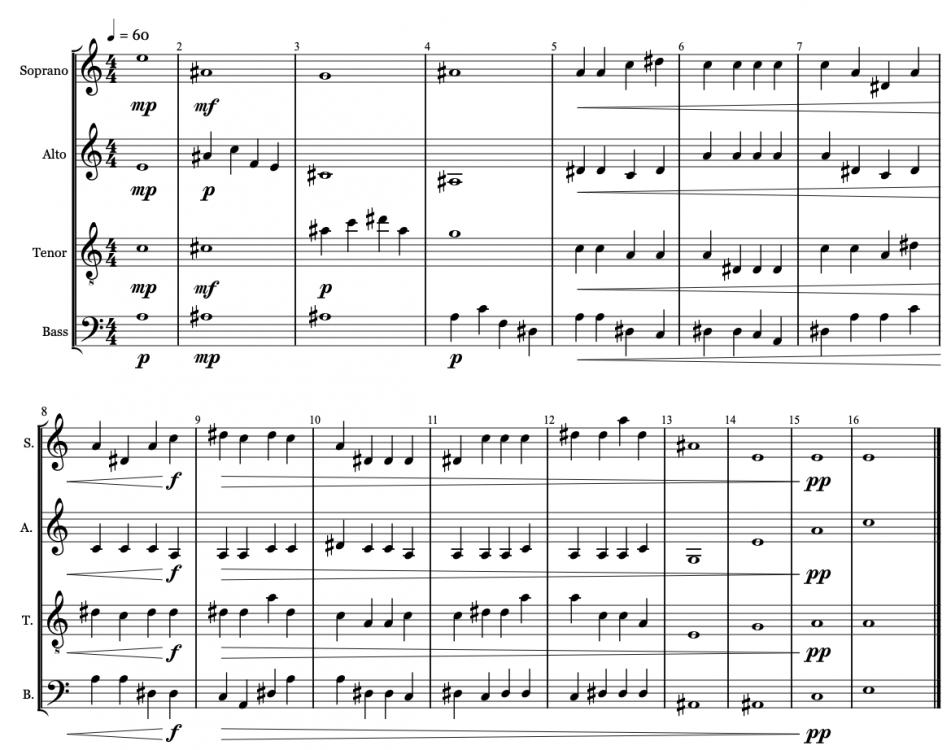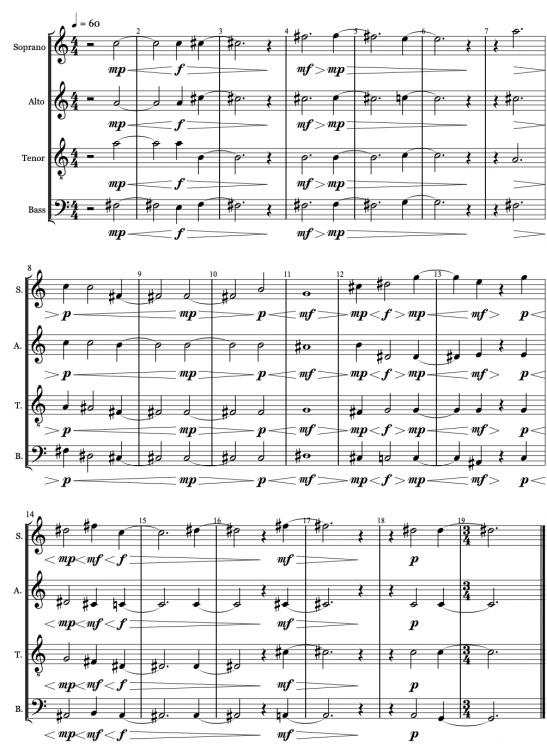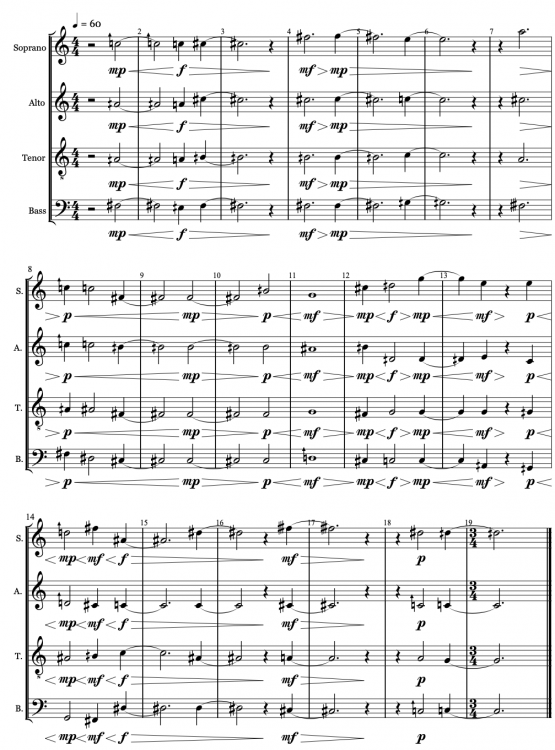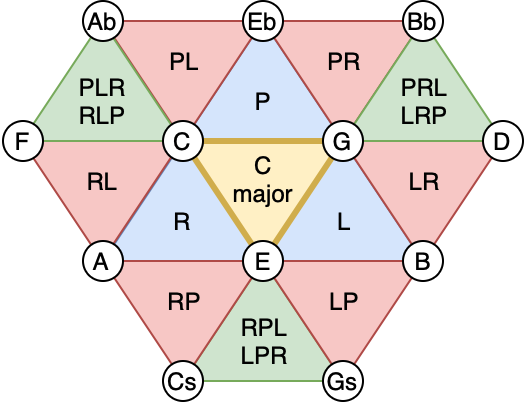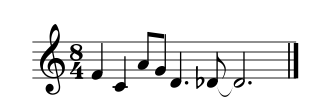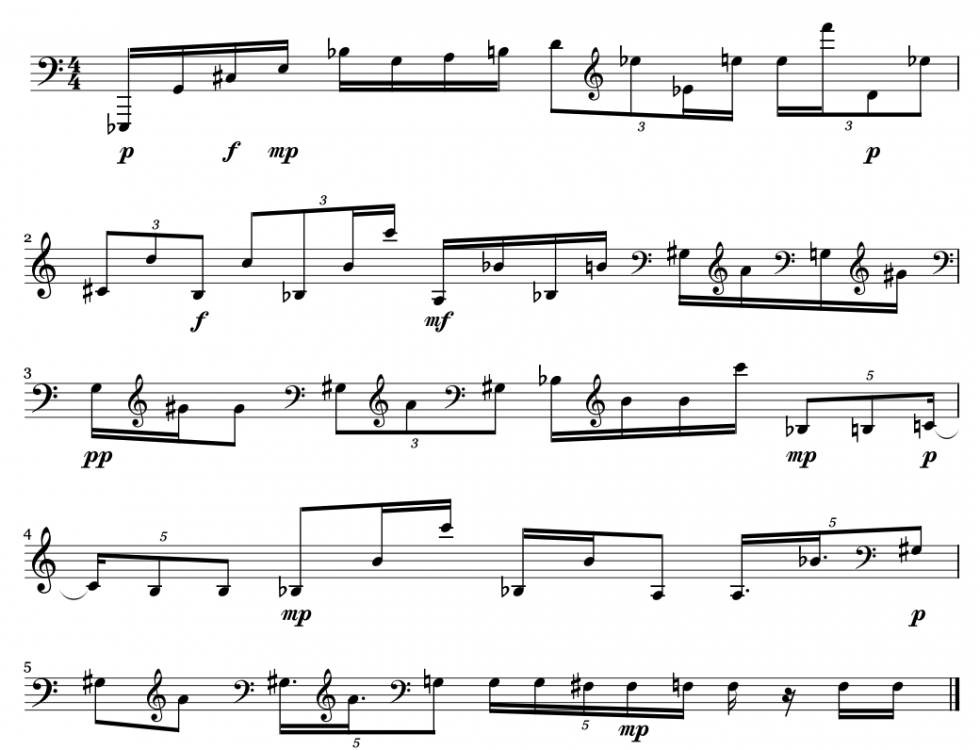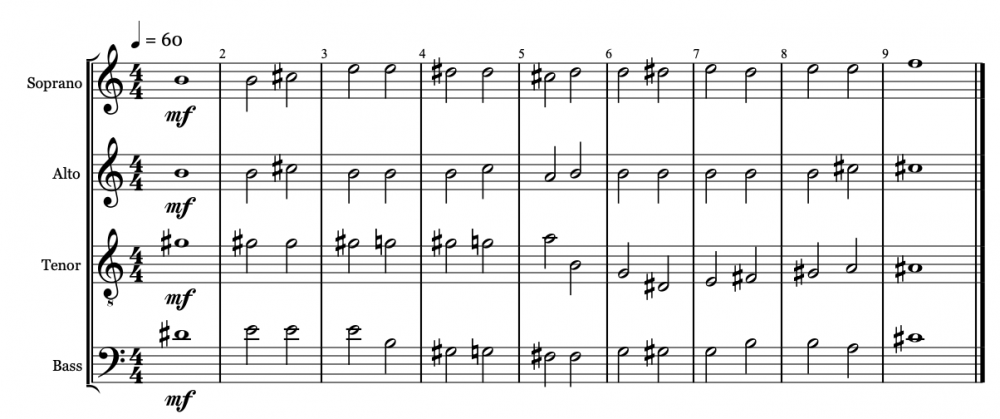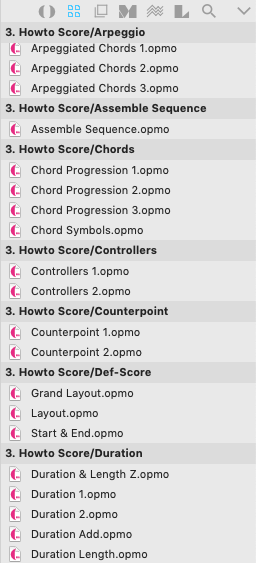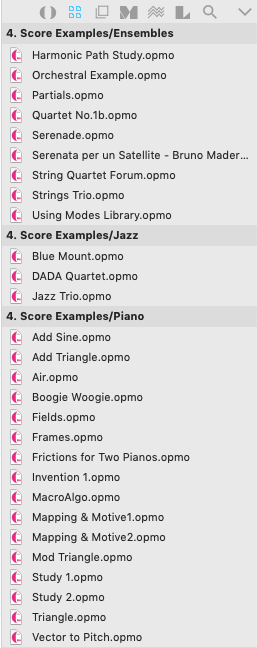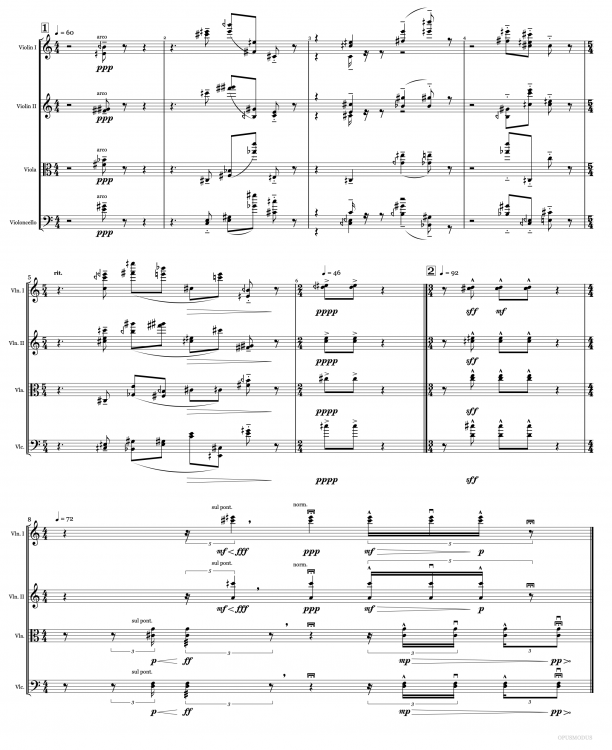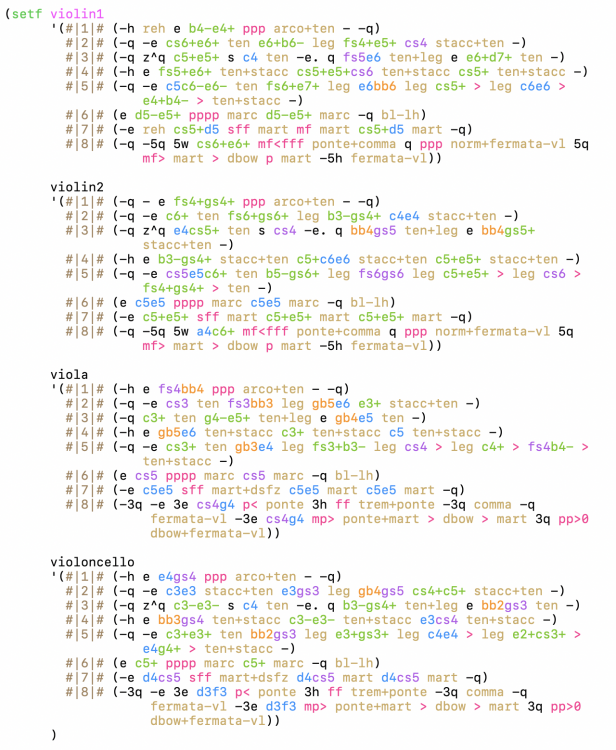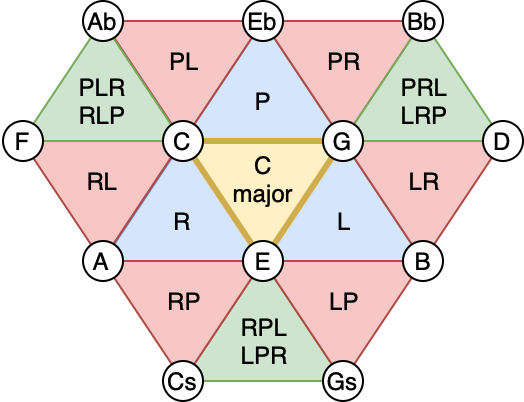-
Posts
2,894 -
Joined
-
Last visited
Content Type
Forums
Events
Store
Video Gallery
Everything posted by opmo
-
Opusmodus 2.0 - New Functions: POLYPHONY The POLYPHONY function allows you to modify unwanted events (interval, velocity or attribute) in a musical texture consisting of two or more simultaneous lines (voices). The unwanted pitch can be removed with (p) symbol (pause), replaced with the an octave (o) of the leading voice or replaced with an interval value in relation to the leading voice pitch. Dictum form: (<interval><pitch-event><velocity><attribute>) in that order. Dictum examples If true: (7 p) 7 - test interval p - pause (7 o) 7 - test interval o - octave (7 t) 7 - test interval t - replaced with the leading voice pitch value (7 p t) 7 - test interval p - pause t - replaced with the leading voice velocity value (7 ? mp t) 7 - test interval ? - at random, octave or pause pp - velocity set to pp t - replaced with the leading voice attribute value (1 13 mp stacc) 1 - test interval 13 - interval replacement in relation to the leading voice pitch mp - velocity set to mp stacc - attribute set to stacc (7 (6 13) t t) 7 - test interval (6 13) - at random, 6 or 13 t - replaced with the leading voice velocity value t - replaced with the leading voice attribute value Leading The leading option is a voice number from which the iteration process will start. If the leading voice is not defined or set to NIL then the first voice in the voice list becomes the leading voice. Iterate The iterate option allows us to control the iteration of the polyphony process. Each repetition of the process is a single iteration, and the outcome of each iteration is then the starting point of the next iteration. If iterate is set to T the process is iterated until all voices complete the process consecutively applying the process each time to the result of the previous polyphony process: 1 (leading voice) on 2 3 4 2 on 3 4 3 on 4 If iterate is set to NIL (default) only a single iteration from the leading voice is triggered: 1 (leading voice) on 2 3 4 Examples: I. (setf v1 '((e c4 d4 e4 f4 g4 a4 b4 c5))) (setf v2 '((e g4 eb4 fs4 a4 c5 eb5 fs5 a5))) (setf v3 '((e c4 eb4 f4 as4 c5 e5 fs5 ab5))) (setf v4 '((e a5 fs5 eb5 c5 a4 fs4 e4 c4))) (setf voices (list v1 v2 v3 v4)) By default the 1st voice in the list is a leading voice from which the POLYPHONY test will start. (polyphony '(7 p) voices) => (((e c4 d4 e4 f4 g4 a4 b4 c5)) ((-e eb4 fs4 a4 c5 eb5 - a5)) ((e c4 eb4 f4 as4 c5 - - ab5)) ((e a5 fs5 eb5 - a4 fs4 - c4))) After POLYPHONY test: II. (setf s1 '((e c4 p ten+leg d4 pp leg e4 mp f4 p g4 pp a4 b4 f c5)) s2 '((e g4 mp eb4 p fs4 a4 c5 mf eb5 fs5 a5)) s3 '((e c4 mp eb4 p f4 as4 c5 e5 fs5 ab5)) s4 '((e a5 mp fs5 p eb5 c5 a4 fs4 e4 c4))) (setf seq (list s1 s2 s3 s4)) If true the pitch will be replaced with the an octave of the leading voice and velocity and articulation event will be replaced with the leading voice events respectively. (polyphony '(7 o t t) seq) (polyphony '((7 6 t t) (1 -13 t t)) seq) III. (setf p1 '(q d4 pp s eb4 leg g4 p leg bb4 leg a4 q. cs5 mf -e 3q gs5 leg fs5 leg c5 b4 ff leg f4 leg e4)) (setf p2 '(t d4 p leg eb4 leg g4 leg bb4 f q. a4 marc t fs4 mf leg gs4 leg e. c5 e b4 t f5 leg e5 leg d5 leg eb5 f 3q bb5 a4 bb5 e a4 pp stacc -e)) (setf p3 '(q d5 leg eb5 3q g4 stacc bb4 stacc a4 stacc e. cs4 marc s gs4 leg q gs4 -q)) (setf p4 '(q. fs5 pp 3e c5 leg b4 leg f4 e d5 mf s eb5 leg g5 leg bb5 leg a5 e fs5 leg fs5 3e gs4 > stacc c5 stacc b5 stacc t f5 pp e.. e5)) (setf patterns (list p1 p2 p3 p4)) The intervals 7, 10 and 11 if found in POLYPHONY will turn to a pause for the length of its value. (polyphony '((7 p) (10 p) (11 p)) patterns) Instead of turning the unwanted interval to a pause, we set the pitch-event to (o) which will replace the pitch with an octave value, taken from the leading voice. (polyphony '((7 o) (10 o) (11 o)) patterns) I the next example the 3rd voice is set to a leading voice. If true, the velocity and the articulation will be replaced with the values of the leading voice. In this example we set the :iterate to T. (polyphony '((7 0 t t) (10 o t t) (11 o t t)) patterns :leading 3 :iterate t) (polyphony '((7 6 t t) (2 10 t t) (1 13 t t)) patterns :leading 2) COUNTERPOINT This function designates patterns to a number of voices with defined methods for each voice. The voices in the COUNTERPOINT dictum list are in sequential numerical order. In the dictum below the 1st voice is assigned to the 1st pattern, the 2nd voice to the 2nd pattern, the 3rd voice to the 1st pattern and the 4th voice to the 2nd pattern. Dictum: ((1 2 1 2) :methods (- - (ri dl.5) (r dl.2)) :polyphony (7 p) :iterate t) voices: 1 2 3 4 patterns: 1 2 1 2 Patterns: (setf p01 '((-5h 5w. e6 5h bb3 -e bb3 q e5 bb4 -) (-q) (-5h b5 5w c5 5h b4 q c6 - 3h b4 - -) (-q))) (setf p02 '((q. f6 -e q. fs6 -e -5h - 5w. b6) (-q) (-3h 3w b5 -3h 3w bb6 5w b5 -5h - -) (-q))) (setf patterns (list p01 p02)) (counterpoint patterns '(((1 2 1 2) :methods (- - (ri dl.5) (r dl.2))))) Methods Each of the voices use their own methods which are defined in the DEF-UNFOLD-SET library. The method symbols are method names used in UNFOLD function. In our example we use the default set 'om which can be found in the Utilities/Library/Default-Unfold-Sets library. It is imperative to understand how the unfold sets are created and how they are working. This will allow you to define your own libraries with your own method names and functions. Let us examine in more detail the methods we are using in our dictum. In the first and second voice the symbol (-) method means, no method is defined (the pattern in the specified voice is unchanged). In the third voice we apply the retrograde-inversion first, then we scale the density of the pattern to 0.5 (mid density) with a length-legato. In the fourth voice we apply retrograde first, then we scale the density of the pattern to 0.2 (low density) with a length-legato. Lets add two more dictums to our example: (counterpoint patterns '(((1 2 1 2) :methods (- - (ri dl.5) (r dl.2))) ((2 2 1 2) :methods (d.8 (d.8 >) (r dl.2) (d.3 ri))) ((2 1 2 2) :methods ((dl.7 t-13) (dl.5 <>) (ri dl.4) (dl.3 r t-7))))) Copy the expressions from above to the Composer panel, evaluate each of them and call the ⌘2 shortcut to audition the result. In the next four voices COUNTERPOINT example we use 8 patterns with a number of dictum lists. Patterns: (setf p1 '(5q. d3 f cs2 pp 5q d1 mp bb1 5q gs1 p a2 f - eb2 5e e3 pp gs2 7e d2 f c2 ff 7q cs3 mf eb3 f - d4 7e c4 bb3 pp 7q e3)) (setf p2 '(7q f2 ff bb2 mp e3 f eb4 7e e3 mp f4 p 7q b3 ppp g4 pp 7q cs4 mp g3 mf 7e. a3 p pp 7q. gs3 mp -7q - 7q g4 p 7e cs5 f g4 7q cs4 mp c5 7e fs5 g6 pp 7q cs7 mf -)) (setf p3 '(5q. cs5 mf 5e. d6 ppp fs5 5q c6 mp cs5 p 5q. g4 mp b3 5q f3 b2 f 5q. f2 f b2 mp 5q eb2 mf 5e d1 f eb2)) (setf p4 '(5q. d2 f cs1 p -5q g1 mp 5q f1 p fs2 mf - 5e c2 p fs2 mf gs2 p g1 f 7q gs2 mp g1 gs2 p 7e g1 f f1 mf -7q b1 f f2 mp)) (setf p5 '(3q e3 bb3 ff 3e b4 mp c6 ff q d6 ff e gs6 a7)) (setf p6 '(e cs5 pp d6 ppp 3q gs6 ff bb6 3e c7 pp b7 f 3e bb6 mp a5 3q b5 pp f5 ppp)) (setf p7 '(e e2 pp bb1 mp b2 ppp g1 ff 5h f2 p 5q b2 g2 gs3 mp)) (setf p8 '(q f4 mf fs5 pp f5 ff)) Span The span option will overwrite the original pattern span with a given length. If the original pattern is longer than the span then the pattern is shortened and vice versa. The span applies to all voices in the list. The symbol (-) in a voice list means the voice is paused for the length of the pattern. All patterns in a voice list will align to the longest (span) pattern in the voice list. If the pattern is shorter than the longest pattern the length-rests will be inserted at the end of the pattern. Extend The extend option allows you to place the additional length-rests at the start of the pattern with the symbol (s). Polyphony The polyphony option allows you to avoid unwanted intervals in the voice polyphony and modify the velocity or attributes (articulations) values. The unwanted interval can be removed with (p) symbol (pause), replaced with an octave (o) of the leading voice or be replaced with an interval value in relation to the leading voice pitch. Leading The leading option is a voice number from which the iteration process will start. If the leading voice is not defined or set to NIL then the first voice in the voice list becomes the leading voice. Iterate The iterate option allows us to control the iteration of the polyphony process. Each repetition of the process is a single iteration, and the outcome of each iteration is then the starting point of the next iteration. If iterate is set to T the process is iterated until all voices complete the process consecutively applying the process each time to the result of the previous polyphony process: 1 (leading voice) on 2 3 4 2 on 3 4 3 on 4 If iterate is set to NIL (default) only a single iteration from the leading voice is triggered: 1 (leading voice) on 2 3 4 Globals The global-methods and global-polyphony option is used at the end of the process if a global process is required to an individual voice sequence. Examples: (setf voices (counterpoint (list p1 p2 p3 p4 p5 p6 p7 p8) '(((- 7 1 -) :span 5/4 :methods (- (i dl.7) (dl.7 r) -) :polyphony (7 p) :leading 3) ((- 6 3 8) :span 3/4 :methods (- ri (t7 >) <) :polyphony (7 p)) ((7 2 5 -) :span 3/4 :methods ((d.4 r) - ri -) :polyphony (7 p)) ((6 3 8 -) :span 3/2 :methods (d.2 < i -) :polyphony (7 p)) ((- 5 - -) :span 5/4 :methods (- (i d.8) - -)) ((4 8 - 4) :span 3/2 :methods (- ri - ri) :polyphony (7 p)) ((- - - 4) :span 3/2 :methods (- - - ><)) ((8 - 4 8) :span 5/4 :methods ((i > d.2) (d.2) (d.2) (d.2)) :polyphony (7 p)) ((- 3 8 -) :span 5/4 :methods (- (dl.2 i) <> -) :polyphony (7 p)) ((3 8 - 4) :span 3/2 :methods (< - - <>) :polyphony ((7 p) (1 p) (11 p))) (- :span 3/4) ((- 6 - 8) :methods (- > - ><) :polyphony (7 ?)) ((- - 4 6) :methods (- - > (d.2 ll)) :polyphony (7 ?)) ((- 4 8 3) :methods (- - - v?) :polyphony (7 p) :leading 4) ((- 4 6 8) :methods (- d.2 - (d.8 <>)) :polyphony (7 ?)) ((6 - 8 -) :methods ((i > d.3) - > -) :polyphony (7 ?)) ((3 8 - 4) :methods (- ri - (d.2 r ll)) :polyphony (7 ?)) ((1 2 - 3) :methods (>< (d.8 <>) - -) :polyphony (7 ?))) :global-methods '((fl) ;voice 1 (t12 cl) ;voice 2 (hn) ;voice 3 (t-12 vc) ;voice 4 ))) In the PS function we assign each voice to an instrument and the ASSEMBLE-VOICES function helps us to extract a particular voice number: (ps 'gm :fl (list (assemble-voices 1 voices)) :cl (list (assemble-voices 2 voices)) :hn (list (assemble-voices 3 voices)) :vc (list (assemble-voices 4 voices)) :octave-shift '(c2 a6) :tempo (gen-tempo '(44 72 88) '(5 7 11) (assemble-voices 1 voices) :seed 34) :time-signature '(3 4) ) GEN-DICTUM This function allows you to generate a list of voices with a number of optional dictum methods. This function is a companion to the COUNTERPOINT function. The simplest use of the function: (gen-dictum '((6 - 1 2) (3 2 1 6) (- 1 2 3) (2 1 6 2))) => (((6 - 1 2) :span nil :extend nil :methods nil :polyphony nil :leading nil :iterate nil) ((3 2 1 6) :span nil :extend nil :methods nil :polyphony nil :leading nil :iterate nil) ((- 1 2 3) :span nil :extend nil :methods nil :polyphony nil :leading nil :iterate nil) ((2 1 6 2) :span nil :extend nil :methods nil :polyphony nil :leading nil :iterate nil)) Examples: In the examples below we use the GEN-PROB and RND-ORDER functions to generate the voice lists and the optional dictum values: (setf voice-weight '((1 .4) (2 .2) (3 .4) (4 .3) (5 .2) (6 .3) (- .5))) (setf voices (gen-eval 12 '(gen-prob 4 voice-weight) :seed 34)) => ((- 3 4 -) (6 5 4 3) (3 4 - 1) (5 4 3 4) (4 - 1 3) (4 3 4 1) (- 1 3 3) (3 4 1 6) (1 3 3 4) (4 1 6 2) (3 3 4 3) (1 6 2 4)) (setf span-weight '((3/4 .3) (6/4 .2) (5/4 .5))) (setf span (flatten (gen-eval 12 '(gen-prob 1 span-weight) :seed 53))) => (5/4 5/4 5/4 3/2 3/2 5/4 5/4 3/4 5/4 5/4 3/4 5/4) (setf extend (gen-eval 12 '(rnd-order '(s - s -) :encode nil) :seed 27)) => ((- - s s) (- - s s) (- - s s) (- - s s) (- s s -) (- s - s) (s s - -) (- s s -) (s - s -) (- s s -) (- s s -) (- s s -)) (gen-dictum voices :span span :extend extend :print t) Listener: (setf name '( #|1|# ((- 3 4 -) :span 5/4 :extend (- - s s) :methods nil :polyphony nil :leading nil :iterate nil) #|2|# ((6 5 4 3) :span 5/4 :extend (- - s s) :methods nil :polyphony nil :leading nil :iterate nil) #|3|# ((3 4 - 1) :span 5/4 :extend (- - s s) :methods nil :polyphony nil :leading nil :iterate nil) #|4|# ((5 4 3 4) :span 3/2 :extend (- - s s) :methods nil :polyphony nil :leading nil :iterate nil) #|5|# ((4 - 1 3) :span 3/2 :extend (- s s -) :methods nil :polyphony nil :leading nil :iterate nil) #|6|# ((4 3 4 1) :span 5/4 :extend (- s - s) :methods nil :polyphony nil :leading nil :iterate nil) #|7|# ((- 1 3 3) :span 5/4 :extend (s s - -) :methods nil :polyphony nil :leading nil :iterate nil) #|8|# ((3 4 1 6) :span 3/4 :extend (- s s -) :methods nil :polyphony nil :leading nil :iterate nil) #|9|# ((1 3 3 4) :span 5/4 :extend (s - s -) :methods nil :polyphony nil :leading nil :iterate nil) #|10|# ((4 1 6 2) :span 5/4 :extend (- s s -) :methods nil :polyphony nil :leading nil :iterate nil) #|11|# ((3 3 4 3) :span 3/4 :extend (- s s -) :methods nil :polyphony nil :leading nil :iterate nil) #|12|# ((1 6 2 4) :span 5/4 :extend (- s s -) :methods nil :polyphony nil :leading nil :iterate nil) ) ) To use the output of the function from above as a counterpoint template, we copy the result from the Listener panel and paste it into the COUNTERPOINT function: (counterpoint patterns '( #|1|# ((- 3 4 -) :span 5/4 :extend (- - s s) :methods nil :polyphony nil :leading nil :iterate nil) #|2|# ((6 5 4 3) :span 5/4 :extend (- - s s) :methods nil :polyphony nil :leading nil :iterate nil) #|3|# ((3 4 - 1) :span 5/4 :extend (- - s s) :methods nil :polyphony nil :leading nil :iterate nil) #|4|# ((5 4 3 4) :span 3/2 :extend (- - s s) :methods nil :polyphony nil :leading nil :iterate nil) #|5|# ((4 - 1 3) :span 3/2 :extend (- s s -) :methods nil :polyphony nil :leading nil :iterate nil) #|6|# ((4 3 4 1) :span 5/4 :extend (- s - s) :methods nil :polyphony nil :leading nil :iterate nil) #|7|# ((- 1 3 3) :span 5/4 :extend (s s - -) :methods nil :polyphony nil :leading nil :iterate nil) #|8|# ((3 4 1 6) :span 3/4 :extend (- s s -) :methods nil :polyphony nil :leading nil :iterate nil) #|9|# ((1 3 3 4) :span 5/4 :extend (s - s -) :methods nil :polyphony nil :leading nil :iterate nil) #|10|# ((4 1 6 2) :span 5/4 :extend (- s s -) :methods nil :polyphony nil :leading nil :iterate nil) #|11|# ((3 3 4 3) :span 3/4 :extend (- s s -) :methods nil :polyphony nil :leading nil :iterate nil) #|12|# ((1 6 2 4) :span 5/4 :extend (- s s -) :methods nil :polyphony nil :leading nil :iterate nil) )) MAKE-DICTUM The MAKE-DICTUM macro generates a counterpoint template with a number of dictum lists. Every list contains a list of voices and methods ready to be defined by the composer. This function is a companion to the COUNTERPOINT function. Examples: (make-dictum 4 12) The result in the Listener: (counterpoint patterns '( #|1|# ((- - - -) :span nil :extend nil :methods (- - - -) :polyphony nil :leading nil :iterate nil) #|2|# ((- - - -) :span nil :extend nil :methods (- - - -) :polyphony nil :leading nil :iterate nil) #|3|# ((- - - -) :span nil :extend nil :methods (- - - -) :polyphony nil :leading nil :iterate nil) #|4|# ((- - - -) :span nil :extend nil :methods (- - - -) :polyphony nil :leading nil :iterate nil) #|5|# ((- - - -) :span nil :extend nil :methods (- - - -) :polyphony nil :leading nil :iterate nil) #|6|# ((- - - -) :span nil :extend nil :methods (- - - -) :polyphony nil :leading nil :iterate nil) #|7|# ((- - - -) :span nil :extend nil :methods (- - - -) :polyphony nil :leading nil :iterate nil) #|8|# ((- - - -) :span nil :extend nil :methods (- - - -) :polyphony nil :leading nil :iterate nil) #|9|# ((- - - -) :span nil :extend nil :methods (- - - -) :polyphony nil :leading nil :iterate nil) #|10|# ((- - - -) :span nil :extend nil :methods (- - - -) :polyphony nil :leading nil :iterate nil) #|11|# ((- - - -) :span nil :extend nil :methods (- - - -) :polyphony nil :leading nil :iterate nil) #|12|# ((- - - -) :span nil :extend nil :methods (- - - -) :polyphony nil :leading nil :iterate nil) ) :global-methods '(- - - -) :global-polyphony nil ) Depending on your rules and methods the defined counterpoint template could look something like this: (setf Sec-A (counterpoint patterns '( #|1|# ((2 - 7 4) :span nil :extend nil :methods (d.2 - v? -)) #|2|# ((4 10 9 10) :span nil :extend nil :methods (- d.6 - (d.4 r))) #|3|# ((- 4 8 9) :span nil :extend nil :methods (- d.2 - ri)) #|4|# ((- 13 - 12) :span nil :extend nil :methods (- i - t6)) #|5|# ((- - - 13) :span nil :extend nil :methods (- - - d.7)) #|6|# ((9 12 - -) :span nil :extend nil :methods (i d.8 - -)) #|7|# ((- 1 7 11) :span nil :extend nil :methods (- ri r i)) #|8|# ((10 4 3 1) :span nil :extend nil :methods (i > - <)) #|9|# ((8 8 - 8) :span nil :extend nil :methods (>< <> - d.3)) #|10|# ((1 8 - 3) :span nil :extend nil :methods (v? (d.6 i) - d.3)) #|11|# ((- 3 9 4) :span nil :extend nil :methods (- - i -)) #|12|# ((8 13 9 -) :span nil :extend nil :methods (d.6 d.3 d.2 -))) :global-methods '((dyn fl) (dyn cl) (t-12 dyn hn) (t-12 dyn vc)) :global-polyphony '(7 p))) ASSEMBLE-VOICES ASSEMBLE-VOICES is a twofold operation function. If the index value is a number, the function returns a list of that number. If the index value is a name the function will set indexed variable names to all the voices in the list. The index value set to NIL will return all voices in the list. The assembling of the voices is made by the matrix-transpose operation on a list of lists. This function is a companion to the COUNTERPOINT function. Examples: (setf sec-a (counterpoint patterns '(((5 - - -)) ((4 - - -)) ((2 - - -)) ((3 - - -)) (- :span 2/4)) :global-methods '((dyn fl) - - -))) (setf sec-b (counterpoint patterns '(((- 5 2 -) :span 3/4 :methods (- ri - -)) ((- 2 2 6) :span 3/4 :methods (- > (dl.3) -)) ((5 1 - 5) :span 3/4 :methods (- (dl.2) - i)) ((1 2 6 3) :span 2/4 :methods (< ri i -)) ((- 1 5 3) :span 5/4 :methods (- > t7 i)) ((2 6 3 -) :span 3/4 :methods (- < - ri)) ((5 5 8 3) :span 3/4 :methods ((dl.3 i) >< > -)) ((3 3 - 4) :span 2/4 :methods ((i >) (dl.2 i) - (dl.3))) ((- 7 - 7) :span 3/4 :methods (- i - (t-12 ri))) ((4 6 6 8) :span 2/4 :methods (< (dl.2) r -)) (- :span 2/4)) :global-methods '((dyn fl) (dyn cl) (t-12 dyn hn) (t-12 dyn vc)))) (setf sec-c (counterpoint patterns '(((7 4 - 5) :methods (< > i v?) :extend (s - s -)) ((- 3 4 -) :methods (- < > -) :extend (s - s -)) ((2 - 8 1) :methods (- - - v?) :extend (s - s -)) ((8 8 6 6) :methods (< > - (dl.2 i)) :extend (s - s -)) ((- 3 3 -) :methods (- i (dl.2) -) :extend (s - s -)) ((- 4 8 -) :methods (- (ri dl.2) > -) :extend (s - s -)) ((1 2 2 3) :methods (< > i -) :extend (s - s -))) :global-methods '((dyn fl) (dyn cl) (t-12 dyn hn) (t-12 dyn vc)))) (setf sec-d (counterpoint patterns '(((- 3 - -) :methods (- - - -)) ((- 2 - -) :methods (- - - -)) ((- 4 - -) :methods (< - - -)) ((1 1 1 1) :methods (>< <> (r dl.2) (i dl.2)))) :global-methods '((dyn fl) (dyn cl) (dyn hn) (dyn vc)))) Returns 1st voice from all sections: (assemble-voices 1 sec-a sec-b sec-c) Returns 4th voice from all sections: (assemble-voices 4 sec-a sec-b sec-c) Sets indexed variable names to all voices in the sections: (assemble-voices 'vox sec-a sec-b sec-c) => (vox1 vox2 vox3 vox4) CHORALIS The function CHORALIS returns four voice polyphony (soprano, alto, tenor and bass) by sorting the voices and taking the closest path to the previous chord. There are three path options: closest, relative and comparative. The ambitus for each voice can be defined with the ambitus option. The default ambitus for bass is (-20 5), for tenor (-10 9), for alto (-7 14) and for soprano (2 21). The ambitus form is: '((-20 5) (-10 9) (-7 14) (2 21)) or '(bass tenor alto soprano). The interval option, defines the largest interval step in a voice. Each of the voices can be modified by methods which are defined in the DEF-UNFOLD-SET library. The method symbols are method names used in the UNFOLD function. The default set 'om can be found in the Utilities/Library/Default-Unfold-Sets library. The methods can be applied to a bar and events. Transposition 6 applied to 6th bar: (t5 6) Transposition -12 applied to 4th bar, events 1 and 2 only: (t-12 4 (1 2)) The edit option allows to replace the entire bar with a new events. This option is useful for creating a melodic movement in a voice. Number of chords in a omn-form should be one: (h g4b4d5) To repeat a voice polyphony we add an additional length value: (q e4g4b4 q) (q g4bb4d5 q q q) Examples: I. (setf chords '((w c4e4g4) (h g4b4d5) (h c4e4g4) (-h) (q e4g4b4 q) (q a4c5e5 mp leg q leg) (q g4b4d5 leg) (q f4a4c5) (w d4f4a4) (w a4cs5e5 mf) (-q) (q d4f4a4 q q) (q a4c5e5) (h c4e4g4) (h d4f4a4) (q d4fs4a4 leg q leg q) (h g4b4d5 h) (-q) (q bb4d5f5 q q) (w eb4g4bb4) (-q) (q c4eb4g4 q) (q g4bb4d5) (h c4eb4g4) (h bb4d5f5) (w f4a4c5 h) (-q) (q d4fs4a4) (q g4bb4d5 q q q) (h d4fs4a4 h) (-q) (q g4bb4d5) (h c4eb4g4) (h g4bb4d5) (h d4fs4a4 h) (h. g4bb4d5) (-q) (w g4bb4d5) (h d4f4a4 h) (-q) (q a4c5e5) (q a4c5e5) (q a4c5e5) (h c4eb4g4) (h c4eb4g4) (h g4bb4d5) (q g4bb4d5) (q g4bb4d5) (h d4f4a4) (h d4f4a4) (-q) (q d4f4a4 mf) (q a4c5e5 f) (q d4f4a4 p) (h. b4d5fs5 p) (q d4f4a4 mp) (q f4a4c5 q q q) (w e4g4b4) (h a4c5e5) (-h) (h d4fs4a4) (q d4fs4a4 q) (h g4b4d5) (h g4b4d5) (h e4g4b4) (q e4g4b4) (q e4g4b4) (h. c4e4g4) (q c4e4g4) (h f4a4c5) (q f4a4c5) (q bb4d5f5) (h. g4b4d5) (q c4e4g4) (h a4cs5e5) (h d4f4a4) (q g4b4d5) (q d4fs4a4) (w g4b4d5 p) (w g4b4d5 pp))) (choralis chords :rotation 1 :index 'v :interval 8 :path '? :seed 826083 :methods '(:sop ((t5 6) (t-4 (31 32) (3 1)) (t-12 32 2)) :ten ((t4 (31 32) (3 1))) :bass ((t-12 (1 2 3)) (t-12 4 (1 2))))) (ps 'gm :satb (list v1 v2 v3 v4) :flexible-clef nil :tempo 60) II. Example with edit option: (progn (choralis '((w a4c5e5 p<) (w g4bb4db5 mp< :r 3) (q a4c5eb5 < :r 15) (q a4c5eb5 f) (q a4c5eb5 > :r 16) (w e4g4bb4 > :r 2) (w a4c5e5 pp :r 2)) :rotation '? :path 'relative :index 'voice :methods '( :sop dyn :alt dyn :ten dyn :bass dyn ) :edit '( :alt ((q as4 p c5 f4 e4) 2) :ten ((q as4 p c5 eb5 as4) 3) :bass ((q a3 p c4 f3 eb3) 4) ) :seed 45 ) (ps 'gm :satb (list voice1 voice2 voice3 voice4) :time-signature '(4 4) :flexible-clef nil :tempo 60) ) GEN-CHORALIS This function allows you to generate a list of CHORALIS chords with optional velocity and attributes values. This function is a companion to the CHORALIS function. Examples: I. (setf bartok '(c4eb4g4 c4e4g4 db4fs4a4 eb4g4bb4 e4g4bb4 fs4a4c5 bb4c5ds5 a4c5eb5 a4c5e5 b4db5fs5)) (setf chords (rnd-sample 31 bartok :seed 857438)) => (fs4a4c5 a4c5e5 b4db5fs5 b4db5fs5 b4db5fs5 c4e4g4 db4fs4a4 fs4a4c5 bb4c5ds5 b4db5fs5 b4db5fs5 b4db5fs5 eb4g4bb4 b4db5fs5 c4eb4g4 c4eb4g4 e4g4bb4 c4e4g4 eb4g4bb4 b4db5fs5 bb4c5ds5 bb4c5ds5 db4fs4a4 a4c5eb5 c4eb4g4 a4c5eb5 c4e4g4 a4c5e5 db4fs4a4 c4eb4g4 fs4a4c5) (setf lengths (gen-prob 31 '((h .4) (q .2) (h. .4) (q .3) (-h .2) (-q .3) (w .5)) :seed 441896)) => (-1/2 1 1/4 1 -1/4 3/4 1 1 -1/2 3/4 1/4 1/2 3/4 1 1/2 1 1/4 1/2 1/2 1/4 -1/4 1/4 1/2 1/4 1 3/4 -1/4 1 -1/2 1/2 1) (setf velocity (gen-prob 31 '((p .4) (mp .4) (mf .3) (f .2)) :seed 435)) => (mp f f mf mp mp mp p p p mp p mf mp f mp mf p mp mf f f mf p p mf mp f mf f p) (setf chords (gen-choralis lengths chords :velocity velocity)) => ((-h) (w fs4a4c5 mp) (q a4c5e5 f) (w b4db5fs5 f) (-q) (h. b4db5fs5 mf) (w b4db5fs5 mp) (w c4e4g4 mp) (-h) (h. db4fs4a4 mp) (q fs4a4c5 p) (h bb4c5ds5 p) (h. b4db5fs5 p) (w b4db5fs5 mp) (h b4db5fs5 p) (w eb4g4bb4 mf) (q b4db5fs5 mp) (h c4eb4g4 f) (h c4eb4g4 mp) (q e4g4bb4 mf) (-q) (q c4e4g4 p) (h eb4g4bb4 mp) (q b4db5fs5 mf) (w bb4c5ds5 f) (h. bb4c5ds5 f) (-q) (w db4fs4a4 mf) (-h) (h a4c5eb5 p) (w c4eb4g4 p)) (choralis chords :index 'v :seed 653886 :methods '(:sop dyn :alt dyn :ten dyn :bass dyn)) (ps 'gm :satb (list v1 v2 v3 v4) :flexible-clef nil :time-signature '(4 4) :tempo 60) II. Microtonal example with quarter and eighth tone intervals: (setf mbartok '(c4eb4-g4 c4e4g4+ db4fs4+a4 eb4-..g4bb4 e4g4bb4- fs4a4+c5. bb4c5ds5 a4c5.eb5 a4c5e5+ b4+db5fs5)) (setf mchords (rnd-sample 31 mbartok :seed 857438)) (setf chords2 (gen-choralis lengths mchords :velocity velocity)) (choralis chords2 :index 'm :seed 653886 :methods '(:sop dyn :alt dyn :ten dyn :bass dyn)) (ps 'vsl :satb (list m1 m2 m3 m4) :flexible-clef nil :time-signature '(4 4) :tempo 60) TONNETZ The principal transformations of neo-Riemannian triadic theory connect triads (major and minor), and are their own inverses (a second application undoes the first). These transformations are purely harmonic, and do not need any particular voice leading between chords: all instances of motion from a C major to a C minor triad represent the same neo-Riemannian transformation, no matter how the voices are distributed in register. The three transformations move one of the three notes of the triad to produce a different triad: The P transformation exchanges a triad for its Parallel. In a Major Triad move the third down a semitone (C major to C minor), in a Minor Triad move the third up a semitone (C minor to C major) The R transformation exchanges a triad for its Relative. In a Major Triad move the fifth up a tone (C major to A minor), in a Minor Triad move the root down a tone (A minor to C major) The L transformation exchanges a triad for its Leading-Tone Exchange. In a Major Triad the root moves down by a semitone (C major to E minor), in a Minor Triad the fifth moves up by a semitone (E minor to C major). Observe that P preserves the perfect fifth interval (so given say C and G there are only two candidates for the third note: E and Eb), L preserves the minor third interval (given E and G our candidates are C and B) and R preserves the major third interval (given C and E our candidates are G and A). Secondary operations can be constructed by combining these basic operations: The N (or Nebenverwandt) relation exchanges a major triad for its minor subdominant, and a minor triad for its major dominant (C major and F minor). The N transformation can be obtained by applying R, L, and P successively. The S (or Slide) relation exchanges two triads that share a third (C major and Cs minor); it can be obtained by applying L, P, and R successively in that order. The H relation (LPL) exchanges a triad for its hexatonic pole (C major and Ab minor) Any combination of the L, P, and R transformations will act inversely on major and minor triads: for instance, R-then-P transposes C major down a minor third, to A major via A minor, whilst transposing C minor to Eb minor up a minor 3rd via Eb major. Neo-Riemannian transformations can be modelled with several interrelated geometric structures. The Riemannian Tonnetz (‘tonal grid’, shown below) is a planar array of pitches along three simplicial axes, corresponding to the three consonant intervals. Major and minor triads are represented by triangles which tile the plane of the Tonnetz. Edge-adjacent triads share two common pitches, and so the principal transformations are expressed as minimal motion of the Tonnetz. One step transformation (basic transformations): P (parallel) R (relative) L (leading) Secondary One step transformation (combine transformations): N (RLP) S (LPR) H (LPL) Two step transformations: Parallel: PR and PL Relative: RL and RP Leading: LR and LP Three step transformations: Parallel: PLR and PRL Relative: RLP and RPL Leading: LPR and LRP Reflection: PLR and RLP are equal. PRL and LRP are equal. RPL and LPR are equal. Examples: (tonnetz 'c4e4g4 '(p p r r l l)) => (c4e4g4 c4eb4g4 c4e4g4 c4e4a4 c4e4g4 b3e4g4 c4e4g4) (tonnetz '(c4 e4 g4) '(p p r r l l)) => ((c4 e4 g4) (c4 eb4 g4) (c4 e4 g4) (c4 e4 a4) (c4 e4 g4) (b3 e4 g4) (c4 e4 g4)) (tonnetz 'e4g4b4 '(l r l r p l r l r p)) => (e4g4b4 e4g4c5 e4a4c5 f4a4c5 f4a4d5 fs4a4d5 fs4a4cs5 e4a4cs5 e4gs4cs5 e4gs4b4 e4g4b4) (tonnetz 'ab3c4eb4 '(p l p l p l p l)) => (ab3c4eb4 gs3b3eb4 gs3b3e4 g3b3e4 g3c4e4 g3c4eb4 gs3c4eb4 gs3b3eb4 gs3b3e4) (tonnetz 'ab3c4eb4 '(pl pl pl pl)) => (ab3c4eb4 gs3b3e4 g3c4e4 gs3c4eb4 gs3b3e4) (tonnetz 'c4e4g4 '(p r p r p r p r)) => (c4e4g4 c4eb4g4 bb3eb4g4 bb3eb4fs4 bb3cs4fs4 a3cs4fs4 a3cs4e4 a3c4e4 g3c4e4) (tonnetz '(ab4 m) '(p n l s l n)) => (ab4b4eb5 gs4c5eb5 gs4cs5e5 a4cs5e5 bb4cs5f5 bb4cs5fs5 b4d5fs5) (setf moves (rnd-order '(p l r lr lp rp rl pr pl plr prl rpl) :seed 26)) => (rp rl rpl pr prl lr r p plr pl lp l) (tonnetz 'c4e4g4 moves) => (c4e4g4 cs4e4a4 d4fs4a4 eb4fs4bb4 eb4g4c5 f4a4c5 e4g4c5 e4a4c5 e4a4cs5 f4a4d5 fs4a4cs5 f4a4d5 f4bb4d5) (setf transitions '(p l r lr lp rp rl pr pl plr prl rpl prlpr lrplprpp)) (setf rnd-transition (rnd-sample 15 transitions :seed 750989)) => (prlpr r r p pl pl lrplprpp lr prlpr rpl lp rl prl rl rpl) (tonnetz 'ab3c4eb4 rnd-transition)) => (ab3c4eb4 g3c4eb4 g3bb3eb4 g3c4eb4 g3c4e4 gs3c4eb4 gs3b3e4 f3bb3d4 f3a3c4 e3a3c4 eb3gs3c4 e3g3c4 f3a3c4 eb3g3c4 d3g3bb3 cs3fs3bb3) (tonnetz '(c maj) '(plp rpr lpl rpr lpl lpl rprp lpl)) => (c4e4g4 b3eb4gs4 a3d4fs4 bb3cs4f4 gs3b3e4 g3c4eb4 gs3b3e4 bb3d4f4 a3cs4fs4) (progn (setf transitions '(p l r lr lp rp rl pr pl plr prl rpl prlpr lrplprpp)) (setf rnd-transition (rnd-sample 15 transitions :seed 750989)) (setf tonnetz (tonnetz '(ab5 m) rnd-transition)) (setf chords (gen-choralis '(w h h h h h h h h h h h h h h w) tonnetz)) (choralis chords :rotation -1 :index 'v :interval 6 :path '? :seed 570136 ) (ps 'gm :satb (list v1 v2 v3 v4) :flexible-clef nil :tempo 60) ) DENSITY The DENSITY function will increase or decrease the number of events in a sequence. It will allow you on the fly to change the density and expression of the pattern without changing the original sequence span. (setf pattern '(e f4 e4 c4 - a4 g4 d4 - ab4 db4 eb4 - gb4 bb4 b4 -)) To find out the density of a sequence we call the GET-DENSITY function: (get-density pattern :type :length) => 0.38 Let’s set the density of the sequence to a 0.9 value. This will increase the number of events, knowing the original density is 0.38: (density .9 pattern :seed 45) => (s f4 f4 e4 t t s c4 c4 -e s a4 a4 g4 t t s d4 t t -e s ab4 ab4 t db4 db4 s t eb4 eb4 s -e s gb4 gb4 bb4 bb4 b4 b4 -e) The intervals option allows you to define intervals to align with newly created lengths. (density .9 pattern :intervals '(0 6 1 6) :seed 45) => (s f4 b4 e4 t bb4 e5 s c4 fs4 -e s a4 eb5 g4 t cs5 g5 s d4 t gs4 d5 -e s gs4 d5 t cs4 g4 s t eb4 a4 s -e s fs4 c5 bb4 e5 b4 f5 -e) In the next example we set the density value to 0.5: (density .5 pattern :seed 45) => (e f4 s e4 e4 e c4 - a4 g4 d4 - s ab4 ab4 e db4 s eb4 eb4 -e gb4 bb4 s b4 b4 -e) Below is an example with a low density value 0.2. This will decrease (swallow) a number of events from the sequence: (density .2 pattern :seed 45) => (e f4 mf - c4 - a4 g4 d4 -q e db4 -h.) The legato option will extend the length-note with a sum of length-rests in sequence: (density .2 pattern :seed 45 :legato t) => (q f4 c4 e a4 g4 q. d4 h.. db4) Examples: (setf sequence '((s eb1 p g2 cs3 f e3 mp bb3 g3 a3 b3 3h d4 eb4 d4 p) (3h cs4 p b3 f bb3 e a3 mf bb3 gs3 g3) (q g3 pp 3h gs3 3q q bb3 5h mp b3 5q c4 p tie) (5q c4 p 5h b3 b3 q bb3 mp e bb3 a3 5h. a3 5h gs3 p) (q gs3 mf 5h. gs3 5h g3 5q g3 g3 fs3 fs3 mp f3 s f3 - f3 =))) Original density: (get-density sequence :type :length) => (0.69 0.44 0.44 0.5 0.69) (density '(1.0 .95 .8 .75 .8) sequence :intervals '(0 13 1 11) :seed 23) (density '(.3 .1 .1 .2 .1 .2) sequence :seed 23) (density '(.3 .1 .1 .2 .1 .2) sequence :legato t :seed 23) MICROTONALITY Microtone pitch symbols and values: + 1/4 - -1/4 . with sharp 1/8 .. with sharp 3/8 . with flat -1/8 .. with flat -3/8 +. with flat or sharp 1/8 +.. with flat or sharp 3/8 -. with flat or sharp -1/8 -.. with flat or sharp -3/8 Quarter tone '(q a4 a4+ as4 as4+ b4 b4- bb4 bb4- a4) Eight tone '(q a4 a4. a4+ a4.. as4 as4. as4+ b4-. b4 b4-. b4- b4-.. bb4 bb4. bb4- a4. a4) Chord '(w c4ds4+g4as4+) Integer, interval and midi microtone values: 0.5 = 1/4 tone 0.25 = 1/8 tone Transposition (pitch-transpose 2.5 '((a4 a4+ b4 d5) (e5 e5+ fs5 a5))) => ((fs4+ g4 gs4+ b4+) (cs5+ d5 ds5+ fs5+)) In the next example we generate a row of quarter tones using RND-ROW function with optional :quantize 1/4. If :quantize is set to 1/8 value, the function will return 8th tone row with 48 values. (setf mat (rnd-row :quantize 1/4 :type :pitch :seed 34)) => (c4 g4 ds4+ cs4 d4+ b4+ f4+ a4+ gs4+ e4+ b4 as4+ e4 bb4 cs4+ a4 d4 g4+ fs4+ eb4 c4+ gs4 fs4 f4) Intervals (pitch-to-interval mat) => (7 -3.5 -2.5 1.5 9 -6 4 -1 -4 6.5 0.5 -6.5 6 -8.5 7.5 -7 5.5 -1 -3.5 -2.5 7.5 -2 -1) (interval-to-pitch '(1.5 2 -1 -1.5 1 .5 .5)) => (c4 cs4+ ds4+ d4+ cs4 d4 d4+ eb4) Hertz to pitch (quantize) (setf hertz '(448 880 1320 1760 2200 2640 3212 3520)) (hertz-to-pitch hertz :quantize 1/4) => (a4+ a5 e6 a6 cs7 e7 g7+ a7) (hertz-to-pitch hertz :quantize 1/8) => (a4. a5 e6 a6 c7.. e7 g7+ a7) Thats all for now. Best wishes, Janusz
-
Function name change
- 8 replies
-
- harmonic path
- coltrane
-
(and 2 more)
Tagged with:
-
Just copy the display with (+) - right corner.
-
(setf mat '((s c4 cs4 gs4 eb4 d4 g4 fs4 a4 e4 bb4 b4 f4) (s c4 d4 eb4 bb4 f4 g4 a4 fs4 b4 e4 gs4 cs4) (s c4 a4 g4 cs4 fs4 b4 f4 eb4 e4 gs4 d4 bb4) (s c4 b4 bb4 f4 e4 d4 cs4 eb4 gs4 fs4 a4 g4) (s c4 gs4 d4 cs4 g4 f4 fs4 eb4 a4 b4 bb4 e4) (s c4 d4 bb4 e4 g4 a4 fs4 b4 eb4 gs4 f4 cs4) (s c4 gs4 cs4 fs4 b4 g4 eb4 f4 a4 d4 e4 bb4) (s c4 b4 fs4 e4 d4 cs4 f4 a4 eb4 bb4 gs4 g4) (s c4 eb4 cs4 g4 f4 gs4 d4 a4 b4 fs4 bb4 e4) (s c4 a4 eb4 fs4 gs4 f4 bb4 d4 b4 g4 e4 cs4) (s c4 cs4 g4 b4 gs4 e4 f4 fs4 d4 eb4 bb4 a4) (s c4 fs4 e4 eb4 cs4 f4 bb4 g4 a4 gs4 d4 b4))) (setf path '(fs4a4c5 a4c5e5 b4db5fs5)) (harmonic-path path mat :octave 'path :time '(1/2 3/4 4/4) :loop t) (harmonic-path path mat :octave 'path :time '(1/2 3/4 4/4) :loop nil) The :time option controls the time (duration) of each path: 1st path fs4a4c5 for 1/3 2nd path a4c5e5 for 3/4 3rd path b4db5fs5 for 4/4 if loop is nil then the last value of the time list (4/4) will apply to each path (its duration): '(1/2 3/4 4/4 4/4 4/4 4/4 4/4 . . .) if loop is set to t then the time list values will repeat again and again: '(1/2 3/4 4/4 1/2 3/4 4/4 1/2 3/4 4/4 . . .) If you path is a list or one chord then there is no need for a loop option.
-
You find many examples in the Utilities panel in the 'Howto Score' and the 'Score Examples' section:
-
The menu is changing with time. As for the lesson 2 file 4, first you need to evaluate the expressions in the main score file: 2. Full Score.
-
(let ((out (pcs-cardinal 4 :forte))) (loop for i in (pcs-super-sets 4 (pcs '3-1) :forte) do (setf out (remove i out)) finally (return out))) (let ((rem (pcs-cardinal 7 :forte)) (super (pcs-super-sets 7 (pcs '3-1) :forte))) (loop for i in super do (setf rem (remove i rem)) finally (return rem))) => (7-31 7-31b 7-32 7-32b 7-34 7-35) here it is.
-
The shortcut keys have changed.
-
All the tutorials on our Forum you will find in the Opusmodus application documentation. Using texts from the web pages (code, examples, etc...) can produce an error.
-
Updates are made frequently and are for free. Upgrades (1.2 .1.3 1.4 etc...) are payable. If you buy 1.3 now you are exempt form the upgrade payment for 4 months. Our last upgrade from version 1.2 to 1.3 was €145. From ver. 1.4 onwards all our upgrades will cost €99.
-
Upcoming Opusmodus ver. 1.4 microtonal notation display and playback (MTS). Luigi Nono, Fragmente-Stille, An Diotima (fragment - 26/27). Best wishes and happy holidays, Janusz
-

solved [SOLVED] Idea for a Rhythmic Set Theory Function
opmo replied to JulioHerrlein's topic in Function Examples
(polygon-rhythm (pcs '7-35) 20 1) (polygon-rhythm (pcs '7-35) 12 1) (pcs-rhythm '7-35 :points 12 :value 1/12) (pcs-rhythm '7-35 :points 12 :value 1/8) (pcs-rhythm '7-35 :points 10 :value 1/20)- 40 replies
-
- pitches-rhythm isomorphism
- toussaint
- (and 6 more)
-
Should work with the next release 1.4
-
Many transformations indeed :-)
-
Following our successful presentation in the Museo di Storia Naturale in Venice on the 7th December, Achim Bornhoeft and I spent some time talking and playing with the Neo-Riemann theory with an outcome of a diagram and a function. This will be part of the next release. Post-Riemann Transformations on a C major triad One step transformation (basic transformations): P (parallel) R (relative) L (leading) Two step transformations: Parallel: PR and PL Relative: RL and RP Leading: LR and LP Three step transformations: Parallel: PLR and PRL Relative: RLP and RPL Leading: LPR and LPR Reflection: PLR and RLP are equal. PRL and LRP are equal. RPL and LPR are equal. Examples: (tonnetz 'c4e4g4 '(p p r r l l)) => (c4e4g4 c4eb4g4 c4e4g4 c4e4a4 c4e4g4 b3e4g4 c4e4g4) (tonnetz '(c4 e4 g4) '(p p r r l l)) => ((c4 e4 g4) (c4 eb4 g4) (c4 e4 g4) (c4 e4 a4) (c4 e4 g4) (b3 e4 g4) (c4 e4 g4)) (tonnetz 'e4g4b4 '(l r l r p l r l r p)) => (e4g4b4 e4g4c5 e4a4c5 f4a4c5 f4a4d5 fs4a4d5 fs4a4cs5 e4a4cs5 e4gs4cs5 e4gs4b4 e4g4b4) (tonnetz 'ab3c4eb4 '(p l p l p l p l)) => (ab3c4eb4 gs3b3eb4 gs3b3e4 g3b3e4 g3c4e4 g3c4eb4 gs3c4eb4 gs3b3eb4 gs3b3e4) (tonnetz 'ab3c4eb4 '(pl pl pl pl)) => (ab3c4eb4 gs3b3e4 g3c4e4 gs3c4eb4 gs3b3e4) (tonnetz 'c4e4g4 '(p r p r p r p r)) => (c4e4g4 c4eb4g4 bb3eb4g4 bb3eb4fs4 bb3cs4fs4 a3cs4fs4 a3cs4e4 a3c4e4 g3c4e4) (setf moves (rnd-order '(p l r lr lp rp rl pr pl plr prl rpl) :seed 26)) => (rp rl rpl pr prl lr r p plr pl lp l) (tonnetz 'c4e4g4 moves) => (c4e4g4 cs4e4a4 d4fs4a4 eb4fs4bb4 eb4g4c5 f4a4c5 e4g4c5 e4a4c5 e4a4cs5 f4a4d5 fs4a4cs5 f4a4d5 f4bb4d5) (setf transitions '(p l r lr lp rp rl pr pl plr prl rpl prlpr lrplprpp)) (setf rnd-transition (rnd-sample 15 transitions :seed 750989)) => (prlpr r r p pl pl lrplprpp lr prlpr rpl lp rl prl rl rpl) (tonnetz 'ab3c4eb4 rnd-transition)) => (ab3c4eb4 g3c4eb4 g3bb3eb4 g3c4eb4 g3c4e4 gs3c4eb4 gs3b3e4 f3bb3d4 f3a3c4 e3a3c4 eb3gs3c4 e3g3c4 f3a3c4 eb3g3c4 d3g3bb3 cs3fs3bb3) (tonnetz '(c maj) '(plp rpr lpl rpr lpl lpl rprp lpl)) => (c4e4g4 b3eb4gs4 a3d4fs4 bb3cs4f4 gs3b3e4 g3c4eb4 gs3b3e4 bb3d4f4 a3cs4fs4)
-

Bizarre hanging on function gen-sieve (probably loop)
opmo replied to JulioHerrlein's topic in Function Examples
Use positive values only. '(1 -1) could go for ever -
We have some problem with CCL compiler on Catalina. We are working on it.
-
Of course all depends on what Vienna Instrument present you are loading into the Vienna Ensember Pro app. With both.
- 27 replies
-
- programs
- def-sound-set
-
(and 2 more)
Tagged with:
-
And if the :sound is 'gm then :program is the instrument name or an integer of the gm setup with :port set to nil.
- 27 replies
-
- programs
- def-sound-set
-
(and 2 more)
Tagged with:
-
Here is my VSL instrument setup example: :sq (:layout string-quartet-layout :port 3 :channel '(1 2 3 4) :sound '(vi-violin vi-violin vi-viola vi-cello) :program 0 :controllers nil :pan (pan '(-30 -10 10 30)) :volume 92) As you can see the :program is set to 0. The program is not important here, only the :sound is. Here is the Violin sound setup: (in-package :Opusmodus) ;;;--------------------------------------------------------- ;;; VIENNA INSTRUMENTS - VIOLIN ;;;--------------------------------------------------------- (def-sound-set vi-violin :programs (:group perf-universal vl-perf-sustain (:key c2 cc1 5) vl-perf-marcato (:key c2 cc1 64) vl-perf-spic (:key c2 cc1 120) :group perf-legato-all vl-perf-legato (:key cs2 :key c1 cc1 40) vl-perf-legato-sul (:key cs2 :key cs1 cc1 40) vl-perf-legato-zigane (:key cs2 :key d1 cc1 40) vl-perf-legato-vib-progr (:key cs2 :key ds1 cc1 40) vl-perf-portamento (:key cs2 :key c1 cc1 80) :group articulation-combi vl-staccato (:key d2 :key c1 cc1 40) vl-sus-vib (:key d2 :key cs1 cc1 40) vl-fp-vib (:key d2 :key d1 cc1 40) vl-trem-sus (:key d2 :key ds1 cc1 40) vl-trill-1 (:key d2 :key e1 cc1 40) vl-pon-staccato (:key d2 :key f1 cc1 40) vl-pon-trem (:key d2 :key fs1 cc1 40) vl-harm-art-stac (:key d2 :key g1 cc1 40) vl-octav-gliss-me (:key d2 :key gs1 cc1 40) vl-pizz (:key d2 :key a1 cc1 40) vl-detache-short (:key d2 :key c1 cc1 80) vl-sus-vib-marc (:key d2 :key cs1 cc1 80) vl-sfz-vib (:key d2 :key d1 cc1 80) vl-trem-sus-af-auto (:key d2 :key ds1 cc1 80) vl-trill-2 (:key d2 :key e1 cc1 80) vl-pon-sus (:key d2 :key f1 cc1 80) vl-pon-trem-fa-auto (:key d2 :key fs1 cc1 80) vl-harm-art-sus (:key d2 :key g1 cc1 80) vl-octav-gliss-fa (:key d2 :key gs1 cc1 80) vl-pizz-snap (:key d2 :key a1 cc1 80) :group pref-repetitions-combi vl-perf-rep-sl (:key ds2 :key c1) vl-perf-rep-por-me (:key ds2 :key cs1) vl-perf-rep-stac (:key ds2 :key d1) vl-perf-rep-spi (:key ds2 :key ds1) vl-perf-rep-harsh (:key ds2 :key e1) :group combi-cre9 vl-rep-cre9-por-fa-1 (:key e2 :key c1 cc1 10) vl-rep-cre9-por-fa-2 (:key e2 :key cs1 cc1 10) vl-rep-cre9-por-fa-3 (:key e2 :key d1 cc1 10) vl-rep-cre9-por-fa-4 (:key e2 :key ds1 cc1 10) vl-rep-cre9-por-fa-5 (:key e2 :key e1 cc1 10) vl-rep-cre9-por-fa-6 (:key e2 :key f1 cc1 10) vl-rep-cre9-por-fa-7 (:key e2 :key fs1 cc1 10) vl-rep-cre9-por-fa-8 (:key e2 :key g1 cc1 10) vl-rep-cre9-por-fa-9 (:key e2 :key gs1 cc1 10) vl-rep-cre9-sta-1 (:key e2 :key c1 cc1 25) vl-rep-cre9-sta-2 (:key e2 :key cs1 cc1 25) vl-rep-cre9-sta-3 (:key e2 :key d1 cc1 25) vl-rep-cre9-sta-4 (:key e2 :key ds1 cc1 25) vl-rep-cre9-sta-5 (:key e2 :key e1 cc1 25) vl-rep-cre9-sta-6 (:key e2 :key f1 cc1 25) vl-rep-cre9-sta-7 (:key e2 :key fs1 cc1 25) vl-rep-cre9-sta-8 (:key e2 :key g1 cc1 25) vl-rep-cre9-sta-9 (:key e2 :key gs1 cc1 25) vl-rep-cre9-spi-1 (:key e2 :key c1 cc1 70) vl-rep-cre9-spi-2 (:key e2 :key cs1 cc1 70) vl-rep-cre9-spi-3 (:key e2 :key d1 cc1 70) vl-rep-cre9-spi-4 (:key e2 :key ds1 cc1 70) vl-rep-cre9-spi-5 (:key e2 :key e1 cc1 70) vl-rep-cre9-spi-6 (:key e2 :key f1 cc1 70) vl-rep-cre9-spi-7 (:key e2 :key fs1 cc1 70) vl-rep-cre9-spi-8 (:key e2 :key g1 cc1 70) vl-rep-cre9-spi-9 (:key e2 :key gs1 cc1 70) vl-rep-cre9-harsh-1 (:key e2 :key c1 cc1 120) vl-rep-cre9-harsh-2 (:key e2 :key cs1 cc1 120) vl-rep-cre9-harsh-3 (:key e2 :key d1 cc1 120) vl-rep-cre9-harsh-4 (:key e2 :key ds1 cc1 120) vl-rep-cre9-harsh-5 (:key e2 :key e1 cc1 120) vl-rep-cre9-harsh-6 (:key e2 :key f1 cc1 120) vl-rep-cre9-harsh-7 (:key e2 :key fs1 cc1 120) vl-rep-cre9-harsh-8 (:key e2 :key g1 cc1 120) vl-rep-cre9-harsh-9 (:key e2 :key gs1 cc1 120) :group perf-harsh-combi vl-sus-vib-fa (:key f2 :key c1 cc1 5) vl-sus-vib-progr (:key f2 :key cs1 cc1 5) vl-pon-sus-fa (:key f2 :key d1 cc1 5) :group omn ord (:key c2 cc1 5) stacc (:key d2 :key c1 cc1 40) stacs (:key e2 :key c1 cc1 25) marc (:key c2 cc1 64) spicc (:key c2 cc1 120) leg (:key cs2 :key c1 cc1 40) tasto (:key cs2 :key cs1 cc1 40) leg+tasto (:key cs2 :key cs1 cc1 40) tasto+leg (:key cs2 :key cs1 cc1 40) vib+marc (:key d2 :key cs1 cc1 80) marc+vib (:key d2 :key cs1 cc1 80) deta (:key d2 :key c1 cc1 80) pizz (:key d2 :key a1 cc1 40) snap (:key d2 :key a1 cc1 80) trem (:key d2 :key ds1 cc1 40) tr1 (:key d2 :key e1 cc1 40) tr2 (:key d2 :key e1 cc1 80) stacc+ponte (:key d2 :key f1 cc1 40) ponte+stacc (:key d2 :key f1 cc1 40) ponte+trem (:key d2 :key fs1 cc1 40) trem+ponte (:key d2 :key fs1 cc1 40) ponte (:key d2 :key f1 cc1 80) ) :controllers (:group default-settings pitch 0 velocity-xf 2 volume 7 pan 10 expression 11 reverb-dry/wet 14 reverb-on/off 15 slot-xf 20 start-scaler 21 master-attack 22 master-release 23 master-filter 24 delay-scaler 25 tuning-scaler 26 humanize 27 velocity-xf-on-off 28 rsamp-on-off 29 dynamics-scaler 30 :group Pedal Ped 64 Sost-Ped 66 Una-Corda 67 :group matrix cc1 1 ) )
- 27 replies
-
- programs
- def-sound-set
-
(and 2 more)
Tagged with:
-
You define the keyswitches in the DEF-SOUND-SET, after, you place the file in the ~/Opusmodus/Def-Libraries/Def-Sound-Sets folder (next time you start the app the file will load automatically). Copy one of the existing files, change the name and fill it will your instrument setup (controllers, keyswitches etc...). All articulation you define in your sound-set can be used in omn. Nothing else you need to do. The list of attributes names you can use in your setup you will find in 4th Element - Attributes doc. You can create your own - if needed - with ADD-TEXT-ATTRIBUTES function. (q c4 stacc) If there is a sound set with a name STACC in your setup then that program (sample) will be triggered. Stephane gives lessons on all OM technics and subjects: https://opusmodus.com/forums/lessons/
- 27 replies
-
- programs
- def-sound-set
-
(and 2 more)
Tagged with:
-
(in-package :Opusmodus) ;;;--------------------------------------------------------- ;;; VIENNA INSTRUMENTS - CELLO (keyswitches) ;;;--------------------------------------------------------- ;; Patches, keyswitches and controllers change events. (def-sound-set VSL-Cello :programs (:group Perf-Legato perf-legato (:key c7) :group Perf-Marcato perf-marcato (:key cs7) :group Perf-Spiccato spiccato (:key d7) :group Short-Notes staccato (:key ds7 :key c1) detache-shot (:key ds7 :key cs1) detache-long (:key ds7 :key d1) :group Long-Notes sus-vib (:key e7 :key c1) sus-vib-marc (:key e7 :key cs1) sus-vib-espr (:key e7 :key d1) sus-vib-progr (:key e7 :key ds1) sus-down (:key e7 :key e1) sus-novib (:key e7 :key f1) :group Dynamic dyn-me-vib-2s (cc1 0 :key f7 :key c1 :key a0) dyn-me-vib-3s (cc1 0 :key f7 :key cs1 :key a0) dyn-me-vib-4s (cc1 0 :key f7 :key d1 :key a0) dyn-str-vib-2s (cc1 25 :key f7 :key c1 :key a0) dyn-str-vib-3s (cc1 25 :key f7 :key cs1 :key a0) dyn-str-vib-4s (cc1 25 :key f7 :key d1 :key a0) dyn-me-novib-2s (cc1 60 :key f7 :key c1 :key a0) dyn-me-novib-3s (cc1 60 :key f7 :key cs1 :key a0) dyn-me-novib-4s (cc1 60 :key f7 :key d1 :key a0) pfp-vib-2s (cc1 100 :key f7 :key c1 :key a0) pfp-vib-4s (cc1 100 :key f7 :key cs1 :key a0) fp-vib (cc1 127 :key f7 :key c1 :key a0) sfz-vib (cc1 127 :key f7 :key cs1 :key a0) sffz-vib (cc1 127 :key f7 :key d1 :key a0) :group Tremolo trem-sus (:key fs7 :key c1 :key a0) trem-sus-fA-auto (:key fs7 :key cs1 :key a0) trem-sus-dyn-2s (:key fs7 :key d1 :key a0) trem-sus-dyn-3s (:key fs7 :key ds1 :key a0) :group Trills trill-1 (cc1 0 :key g7 :key c1 :key a0) trill-1-dyn (cc1 0 :key g7 :key cs1 :key a0) trill-1-acc (cc1 0 :key g7 :key d1 :key a0) trill-1-acc-dyn (cc1 0 :key g7 :key ds1 :key a0) trill-2 (cc1 127 :key g7 :key c1 :key a0) trill-2-dyn (cc1 127 :key g7 :key cs1 :key a0) trill-2-acc (cc1 127 :key g7 :key d1 :key a0) trill-2-acc-dyn (cc1 127 :key g7 :key ds1 :key a0) :group Pizzicato pizzicato (cc1 0 :key gs7 :key c1) col-legno (cc1 0 :key gs7 :key cs1) pizz-secco (cc1 80 :key gs7 :key c1) pizz-snap (cc1 127 :key gs7 :key c1) :group Harmonic-Artificial harm-art-stac (:key a7 :key c1) harm-art-sus (:key a7 :key cs1) harm-art-perf-rep (:key a7 :key d1) :group Harmonic-Natural harm-nat-sus (:key as7 :key c1 :key a0) harm-nat-perf-rep (:key as7 :key cs1 :key a0) harm-nat-gliss (:key as7 :key d1 :key a0) :group Ponticello pon-staccato (cc1 0 :key b7 :key c1 :key a0) pon-sus (cc1 0 :key b7 :key cs1 :key a0) pon-sfz (cc1 0 :key b7 :key d1 :key a0) pon-trem (cc1 0 :key b7 :key ds1 :key a0) pon-perf-rep-leg (cc1 0 :key b7 :key e1 :key a0) pon-detache (cc1 127 :key b7 :key c1 :key a0) pon-sus-fA-auto (cc1 127 :key b7 :key cs1 :key a0) pon-sffz (cc1 127 :key b7 :key d1 :key a0) pon-trem-fA-auto (cc1 127 :key b7 :key ds1 :key a0) pon-perf-rep-dyn-leg (cc1 127 :key b7 :key e1 :key a0) :group Tasto tas-staccato (cc1 0 :key c8 :key c1 :key a0) tas-sus (cc1 0 :key c8 :key cs1 :key a0) tas-sfz (cc1 0 :key c8 :key d1 :key a0) tas-trem (cc1 0 :key c8 :key ds1 :key a0) tas-detache (cc1 127 :key c8 :key c1 :key a0) tas-sus-fA-auto (cc1 127 :key c8 :key cs1 :key a0) tas-trem-fA-auto (cc1 127 :key c8 :key ds1 :key a0) :group OMN leg (:key c7) marc (:key cs7) spicc (:key d7) stacc (:key ds7 :key c1) deta (:key ds7 :key cs1) deta+vib (:key ds7 :key d1) deta+non-vib (:key ds7 :key ds1) vib (:key e7 :key c1) vib+marc (:key e7 :key cs1) non-vib (:key e7 :key f1) trem (:key fs7 :key c1 :key a0) tr1 (cc1 0 :key g7 :key c1 :key a0) tr2 (cc1 127 :key g7 :key c1 :key a0) pizz (cc1 0 :key gs7 :key c1) legno (cc1 0 :key gs7 :key cs1) secco (cc1 80 :key gs7 :key c1) snap (cc1 127 :key gs7 :key c1) harm (:key a7 :key c1 :key a0) harm2 (:key as7 :key c1 :key a0) ponte+stacc (cc1 0 :key b7 :key c1 :key a0) ponte+vib (cc1 0 :key b7 :key cs1 :key a0) ponte+deta (cc1 127 :key b7 :key c1 :key a0) ponte+trem (cc1 0 :key b7 :key ds1 :key a0) tasto+stacc (cc1 0 :key c8 :key c1 :key a0) tasto+vib (cc1 0 :key c8 :key cs1 :key a0) tasto+deta (cc1 127 :key c8 :key c1 :key a0) tasto+trem (cc1 0 :key c8 :key ds1 :key a0) ) :controllers (:group Default-Settings Pitch 0 Velocity-XF 2 Volume 7 Pan 10 Expression 11 Reverb-Dry/Wet 14 Reverb-On/Off 15 Slot-XF 20 Start-Scaler 21 Master-Attack 22 Master-Release 23 Master-Filter 24 Delay-Scaler 25 Tuning-Scaler 26 Humanize 27 Velocity-XF-On-Off 28 Rsamp-On-Off 29 Dynamics-Scaler 30 :group Pedal Ped 64 Sost-Ped 66 Una-Corda 67 :group Matrix cc1 1 ) ) Note the omn group: :group OMN leg (:key c7) marc (:key cs7) spicc (:key d7) stacc (:key ds7 :key c1) deta (:key ds7 :key cs1) deta+vib (:key ds7 :key d1) deta+non-vib (:key ds7 :key ds1) vib (:key e7 :key c1) vib+marc (:key e7 :key cs1) non-vib (:key e7 :key f1) trem (:key fs7 :key c1 :key a0) tr1 (cc1 0 :key g7 :key c1 :key a0) tr2 (cc1 127 :key g7 :key c1 :key a0) pizz (cc1 0 :key gs7 :key c1) legno (cc1 0 :key gs7 :key cs1) secco (cc1 80 :key gs7 :key c1) snap (cc1 127 :key gs7 :key c1) harm (:key a7 :key c1 :key a0) harm2 (:key as7 :key c1 :key a0) ponte+stacc (cc1 0 :key b7 :key c1 :key a0) ponte+vib (cc1 0 :key b7 :key cs1 :key a0) ponte+deta (cc1 127 :key b7 :key c1 :key a0) ponte+trem (cc1 0 :key b7 :key ds1 :key a0) tasto+stacc (cc1 0 :key c8 :key c1 :key a0) tasto+vib (cc1 0 :key c8 :key cs1 :key a0) tasto+deta (cc1 127 :key c8 :key c1 :key a0) tasto+trem (cc1 0 :key c8 :key ds1 :key a0)
- 27 replies
-
- programs
- def-sound-set
-
(and 2 more)
Tagged with:
-
Def-Instrument-Sets are sets to be used with PS function - nothing to do with sound sets. To setup sound set you need to use DEF-SOUND-SET function. In the Library directory you find many examples how to define your own sound set for your instruments.
- 27 replies
-
- programs
- def-sound-set
-
(and 2 more)
Tagged with:
-
What would be the output (values) in your example, what you are looking for. Is this what you are looking for: (<midi value> <time>) (setf data (gen-osc-data 8 (flatten (pitch-to-midi (omn :pitch convert-test))) :time '(1/2 1/4 1/12 1/12 1/12) :min 1 :max 127)) => ((34 1/2) (81 1/4) (54 1/12) (87 1/12) (1 1/12) (127 1/2) (34 1/4) (54 1/12) (54 1/12) (54 1/12) (54 1/2) (54 1/4) (54 1/12) (54 1/12) (54 1/12) (54 1/2) (54 1/4) (54 1/12) (54 1/12) (54 1/12) (54 1/2) (54 1/4) (54 1/12) (54 1/12) (54 1/12) (54 1/2) (54 1/4) (54 1/12) (54 1/12) (54 1/12) (54 1/2) (54 1/4) (54 1/12) (54 1/12) (54 1/12) (54 1/2) (54 1/4) (54 1/12) (54 1/12) (54 1/12)) Or I could add an extra keyword to allow send given values: (setf midi-values '(57 64 60 65 52 71 57 60)) (setf data (gen-osc-data 8 midi-values :time '(1/2 1/4 1/12 1/12 1/12) :values :midi :loop t)) => ((57 1/2) (64 1/4) (60 1/12) (65 1/12) (52 1/12) (71 1/2) (57 1/4) (60 1/12) (57 1/12) (64 1/12) (60 1/2) (65 1/4) (52 1/12) (71 1/12) (57 1/12) (60 1/2) (57 1/4) (64 1/12) (60 1/12) (65 1/12) (52 1/2) (71 1/4) (57 1/12) (60 1/12) (57 1/12) (64 1/2) (60 1/4) (65 1/12) (52 1/12) (71 1/12) (57 1/2) (60 1/4) (57 1/12) (64 1/12) (60 1/12) (65 1/2) (52 1/4) (71 1/12) (57 1/12) (60 1/12))
